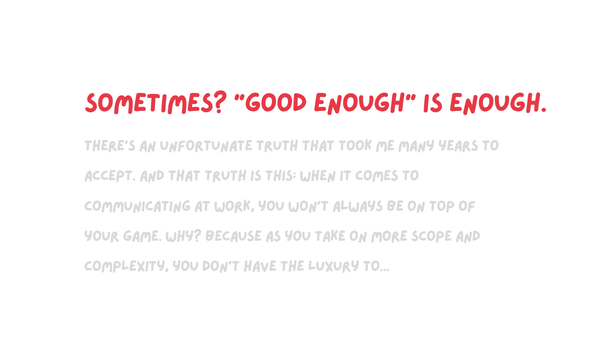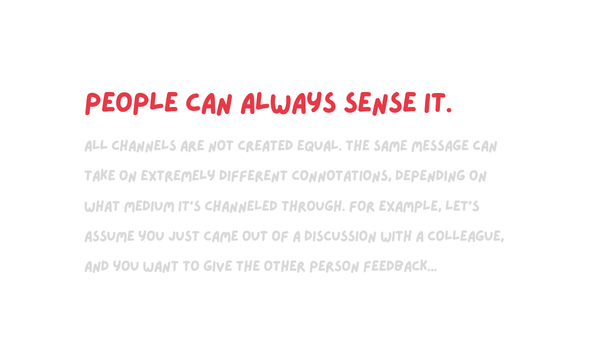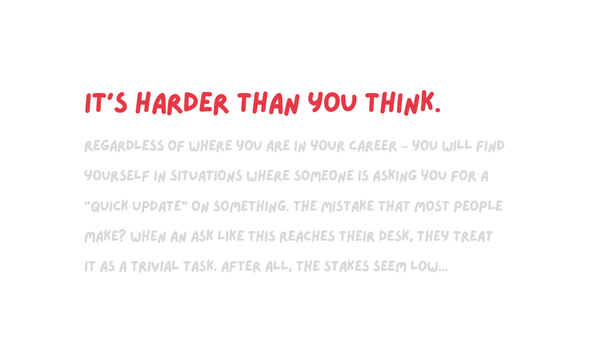Stop drip-feeding people at work.

There's a mistake that happens at work all the time, yet isn't talked about enough: drip-feeding.
And as someone who used to do this a lot without realizing it? I wish it was called out more.
Because once you see it – you can't unsee it. And you realize how much we undermine ourselves when we do it.
So what is drip-feeding exactly? Well, it's exactly what it sounds like. It's giving people information in small and frequent doses.
For example, imagine that you're building a presentation for your stakeholders. So you do the following:
- On Monday, you finish a couple slides. You reach out to your stakeholders for feedback.
- On Wednesday, you finish another couple slides. And you realize you need a couple datapoints. So you reach out again.
- On Thursday, however, you realize that one of the charts you presented needs to be revised. So you fix the chart, and ask for it to be reviewed again.
- You rinse and repeat until you finish all your slides.
Or, consider another example, where you're running a project with many stakeholders. Imagine that you do the following:
- Today, you receive an update that would cause timeline changes. So you send an update to everyone.
- Two days later, you hear about potential budget cuts to the project, but you don't know how much. This feels important though – so you send another update.
- A week later, you get guidance on the exact amount of budget cuts. You think that people definitely want to know this. So you send another update.
- The next day, you receive guidelines on what the budgets can and can't be used for. So you send another email...
It should feel exhausting for you to imagine this scenario – let alone be on the receiving side of it.
But in both these examples, you were nothing but well-intentioned!
After all, you tried to be timely with updates, and you tried to minimize information asymmetry. You did everything right.
And yet somehow – you've also made it rather painful to work with you.
👋 Join 5000+ readers and subscribe to Herng's Newsletter for free:
The issue with drip-feeding
People who drip-feed are rarely ill-intentioned.
In fact, they are often optimizing for timeliness and transparency – which is why they tend to feel such a strong sense of urgency to keep others in the loop.
But what they often forget, is this:
- Drip-feeding creates mental tax. Sure, it might seem harmless to take up only minutes or even seconds of time. It may not even add up to all that much. But every update or request people receive invaraibly comes with a context-switching cost. The mental tax we create is often underestimated.
- Drip-feeding also creates a sense of insecurity. You're effectively conditioning your stakeholders into thinking they're never getting the full picture from you. Instead of being assured by your timeliness – they're already wondering how many more updates are coming.
As a result – a genuine attempt to be helpful ends up backfiring. And you end up with frustrated stakeholders instead.
But make sure you don't overcorrect
What's worse than drip-feeding? It's over-correcting by engaging in what I call dam-building.
What is dam-building? It's the extreme opposite of drip-feeding. You simply don't engage people until you have full visibility or perfect information.
By the time people hear from you, the whole dam has been built (and the water filled up) already.
As the reader forgives me for overstretching this metaphor, here's my point: trying to avoid drip-feeding by overcorrecting can be even more harmful.
For instance, consider the following examples:
- You need to build a dashboard for your team. You start working on it, and no one hears from you until 3 weeks later, when you show up with (what you consider to be) a near-final output. It turns out that the dashboard actually has lots of issues. But by then, you don't have time to action on feedback anymore.
- You're coordinating a new business planning process. There are many moving parts, however, and you don't want to confuse your stakeholders until you have 100% clarity. So you wait for weeks before reaching out. By then, your stakeholders realize they've wasted the last few weeks doing things the wrong way, and they up scrambling before the deadline.
Much like drip-feeding, dam-building behavior actually comes from a place with good intentions. The operator in question is usually trying to make people's lives easier and simpler – not harder.
But what is often overlooked is the following:
- There's an opportunity cost associated with inaction. Sure, everyone prefers to operate when they have full information. But that doesn't give you the right to make them sit on their hands in the meantime. It's often more counterproductive than it is helpful.
- There's often an angst associated with radio silence. You may think you're doing people a favor by not "bothering" them until you have something perfect or near-perfect for them. In reality, this tends to backfire.
- We tend to overestimate the quality of our work. And we underestimate the amount of iteration that needs to occur before something truly lands with our stakeholders. Your "dam" is never as sturdy as you think (i.e. you probably should've checked in earlier).
👋 Subscribe for free to get Herng's newsletter directly in your inbox.
Some guiding principles
Too much drip-feeding, and you exhaust or even frustrate your audience. Too much dam-building, and you create anxiety and distrust.
Needless to say, the preferred alternative to drip-feeding and dam-building is somewhere in the middle.
But how exactly do we find that sweet spot?
There's no perfect solution – and you won't always get it right – but here are some questions that can help bring clarity:
#1 "How time-sensitive is this?"
Ask yourself how urgent a message really is. Ask yourself what incremental value your audience gets by getting bits and pieces from you early (as opposed to receiving a more complete view later on).
If you can't convince yourself of the value – then there's a good case for streamlining your comms.
In any case, if you exercise this discipline most of the time: you'll still get taken seriously when you choose to overcommunicate.
#2 "What downstream dependencies are there?"
Ask yourself if there are any downstream decisions that might be affected by what you choose to communicate. Get a sense of the reversibility of those decisions.
For example: imagine that you anticipate a new process to be rolled out for your stakeholders, yet you do not have full visibility of the details.
In this case, there might still be a case for over-communicating – in case they simply follow last year's process as a default, only to later on find themselves wasting time doing things the wrong way.
#3 "How much does my audience care?"
If you audience cares enough about something – they'll generally appreciate more visibility rather than less.
By the same token – if what you're planning to communicate is low-priority or even perceived as a burden – think twice before you take up people's time and mindspace.
(It might still be OK, of course – but the perceived tax will just be much higher. So your message better be sharper than usual.)
For example: you're building a presentation, and you need data support from a sister team.
In this case, it's clear that they're doing you a favor. You therefore want to be organized and deliver all your asks at once (as opposed to reaching out every other day and asking for a different datapoint).
#4 "How complex is this topic?"
Not everything needs to go through layers of calculus. If what you're communicating is simple and straightforward, then there is merit for over-communicating sometimes.
But even in those cases – be extra sure that you're not overdoing it. Because even getting drip-fed the simplest updates can be frustrating.
#5 "Is there value in establishing 'known unknowns?'"
Remember though: you're not always forced to choose between either drip-feeding or dam-building. You're not forced to choose between the extremes.
Instead, you can achieve the right balance by by saying things like:
- "I don't have formal guidance on marketing budgets for the year yet, but please expect to hear from me within 3 weeks. In the meantime, please prioritize marketing campaigns with the highest expected ROI."
- "I can't yet guarantee whether the same guidelines will still hold this year, but I know that Projects A and B will not be affected. Please proceed as usual there, but hold off on Project C until further guidance."
- "I'm sorry that our data requests aren't completely ready at this point, and that I may need to come back to you a couple more times in the next couple weeks, depending on XYZ feedback. Appreciate your patience!"
Note that in each of these cases, we didn't have "perfect" information or visibility. But we didn't have to choose between drip-feeding and dam-building.
Instead, we found a way to engage by establishing "known unknowns" ("We know that we don't know about X for now").
And when we do that? People then know what to expect (and what not to expect). They won't operate under false assumptions either.
And that can be incredibly helpful.
👋 Join 5000+ readers and subscribe to Herng's Newsletter for free:
Quick recap
"Drip-feeding" is a common mistake most people make early in their careers. But to overcorrect and end up "dam-building" can be equally counterproductive.
In fact, the more perfectionist you are, the easier it is to fall into this trap of withholding information until you deem it to be perfect (or near-perfect).
It almost always ends up backfiring. And that's a shame.
But remember: it's all about the right balance. So when in doubt, ask yourself these questions:
- "How time-sensitive is this?"
- "What downstream dependencies are there?"
- "How much does my audience care?"
- "How complex is this topic?"
- "Is there value in establishing 'known unknowns?'"
And if you found today's issue useful – you'll enjoy reading about why the best operators don't simply "relay information" at work:


